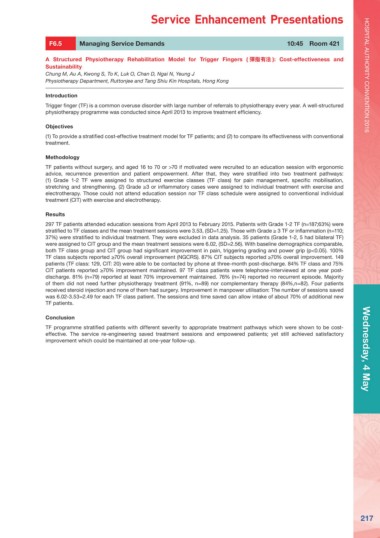Page 219 - HA Convention 2016 [Full Version]
P. 219
Service Enhancement Presentations HOSPITAL AUTHORITY CONVENTION 2016
F6.5 Managing Service Demands 10:45 Room 421
A Structured Physiotherapy Rehabilitation Model for Trigger Fingers ( 彈指有法 ): Cost-effectiveness and
Sustainability
Chung M, Au A, Kwong S, To K, Luk O, Chan D, Ngai N, Yeung J
Physiotherapy Department, Ruttonjee and Tang Shiu Kin Hospitals, Hong Kong
Introduction
Trigger finger (TF) is a common overuse disorder with large number of referrals to physiotherapy every year. A well-structured
physiotherapy programme was conducted since April 2013 to improve treatment efficiency.
Objectives
(1) To provide a stratified cost-effective treatment model for TF patients; and (2) to compare its effectiveness with conventional
treatment.
Methodology
TF patients without surgery, and aged 16 to 70 or >70 if motivated were recruited to an education session with ergonomic
advice, recurrence prevention and patient empowerment. After that, they were stratified into two treatment pathways:
(1) Grade 1-2 TF were assigned to structured exercise classes (TF class) for pain management, specific mobilisation,
stretching and strengthening. (2) Grade ≥3 or inflammatory cases were assigned to individual treatment with exercise and
electrotherapy. Those could not attend education session nor TF class schedule were assigned to conventional individual
treatment (CIT) with exercise and electrotherapy.
Results Wednesday, 4 May
297 TF patients attended education sessions from April 2013 to February 2015. Patients with Grade 1-2 TF (n=187;63%) were
stratified to TF classes and the mean treatment sessions were 3.53, (SD=1.25). Those with Grade ≥ 3 TF or inflammation (n=110;
37%) were stratified to individual treatment. They were excluded in data analysis. 35 patients (Grade 1-2, 5 had bilateral TF)
were assigned to CIT group and the mean treatment sessions were 6.02, (SD=2.56). With baseline demographics comparable,
both TF class group and CIT group had significant improvement in pain, triggering grading and power grip (p<0.05). 100%
TF class subjects reported ≥70% overall improvement (NGCRS). 87% CIT subjects reported ≥70% overall improvement. 149
patients (TF class: 129, CIT: 20) were able to be contacted by phone at three-month post-discharge. 84% TF class and 75%
CIT patients reported ≥70% improvement maintained. 97 TF class patients were telephone-interviewed at one year post-
discharge. 81% (n=79) reported at least 70% improvement maintained. 76% (n=74) reported no recurrent episode. Majority
of them did not need further physiotherapy treatment (91%, n=89) nor complementary therapy (84%,n=82). Four patients
received steroid injection and none of them had surgery. Improvement in manpower utilisation: The number of sessions saved
was 6.02-3.53=2.49 for each TF class patient. The sessions and time saved can allow intake of about 70% of additional new
TF patients.
Conclusion
TF programme stratified patients with different severity to appropriate treatment pathways which were shown to be cost-
effective. The service re-engineering saved treatment sessions and empowered patients; yet still achieved satisfactory
improvement which could be maintained at one-year follow-up.
217

